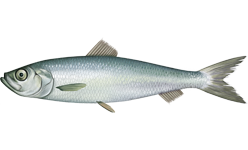Atlantic herring
The Atlantic herring (Clupea harengus) is a kind of herring, a fish. It can be found on both sides of the Atlantic. It can grow up to 45cm in length, weighing more than half a kilogram. It is a swarm fish, meaning many fish come together and form a school (or swarm) of fish. Swarms of up to 4 cubic kilometers in size have been measured of atlantic herring, with an eastimated 4 billion individual fish. Like with so many other fishes though, commercial overfishing is posing a problem. Stocks of herring have been collapsing.
| Atlantic herring | |
|---|---|

| |
| Conservation status | |
| Scientific classification | |
| Kingdom: | Animalia |
| Phylum: | Chordata |
| Class: | Actinopterygii |
| Order: | Clupeiformes |
| Family: | Clupeidae |
| Genus: | Clupea |
| Species: | C. harengus
|
| Binomial name | |
| Clupea harengus | |

| |
| Distribution on a NASA SeaWIFS image | |
Their natural predators are seals, cod, other large fish as well as some kinds of whales. The current reason for the overfishing is the need of the Omega Fatty Acid, which helps increase memory, and brain functions.
Baltic herring
The herrings that occurs in the Baltic Sea is much smaller. Some people consider it a distinct subspecies. They call it Baltic herring, C. harengus membras.
Atlantic Herring Media
Baltic herring from Poland
School of herring ram feeding close to the surface
Global capture production of Atlantic herring (Clupea harengus) in million tonnes from 1950 to 2022, as reported by the FAO Purse seining for Atlantic herring








